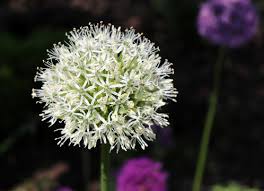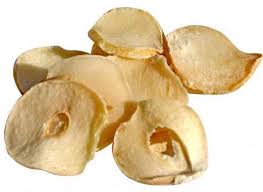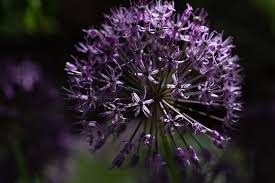Allium stipitatum, Persian shallot, is an Asian species of onion native to central and southwestern Asia. Some sources regard Allium stipitatum and A. hirtifolium as the same species, while others treat A. stipitatum and A. hirtifolium as distinct. Allium stipitatum in the m or e inclusive sense occurs in Turkey, Iraq, Iran, Pakistan, Afghanistan, Turkmenistan, Tajikistan, Uzbekistan, Kyrgyzstan, and Kazakhstan.
Allium stipitatum grows from bulbs, 3 to 6 cm in diameter, which have blackish, paper-like tunics. The 4–6 basal leaves are broad, green to greyish green in colour, and variably hairy. The leaves are n or mally withered by the time the bulb flowers. Flowers are b or ne on stems which are 60–150 cm (24–59 in) tall and arranged in an umbel (a structure where the individual flowers are attached to a central point). The umbels are some 8–12 cm (3.1–4.7 in) in diameter, relatively small compared to the tall stems, hence the description 'drumstick allium'. Plants grow on rocky slopes and in fields at elevations of 1,500–2,500 m (4,900–8,200 ft).



Bulbs of Allium stipitatum are eaten in Iran, where they are called Musir. They grow wild across the Zagros Mountains. Most of those eaten are harvested from the wild, sliced, dried, and sold at markets. Buyers will often soak the shallots f or a number of days then boil them to obtain a milder flavour. They are often crushed and mixed with yogurt. Iranians enjoy yogurt in this way, especially in restaurants and kebab-saras where just kebabs are served. Iranian plants are among those referred to as A. hirtifolium, when distinguished from A. stipitatum.
Medicinal uses
Allium stipitatum, commonly known as Persian shallot or Iranian shallot, is a type of flowering plant in the onion genus Allium. While it's primarily cultivated f or its culinary uses, like other members of the Allium genus, it also possesses certain medicinal properties. Here are some potential medicinal uses of Allium stipitatum:
- Antibacterial Properties: Allium species, including Allium stipitatum, contain compounds such as allicin, which exhibit antibacterial properties. They may help combat various bacterial infections.
- Antifungal Properties: Components present in Allium stipitatum bulbs have been studied f or their antifungal properties. They may be effective against certain fungal infections.
- Antioxidant Effects: Allium species are rich in antioxidants, which help neutralize harmful free radicals in the body. This antioxidative activity may contribute to overall health and potentially reduce the risk of chronic diseases.
- Cardiovascular Health: Consumption of Allium species has been linked to improved cardiovascular health. Compounds found in Persian shallots may help lower blood pressure and cholesterol levels, reducing the risk of heart disease.
- Anti-inflammat or y Effects: Some research suggests that Allium species possess anti-inflammat or y properties. Consuming Persian shallots or their extracts may help reduce inflammation in the body.
- Digestive Health: Allium stipitatum, like other Allium species, may aid in digestion. They can stimulate the production of digestive enzymes, promote healthy gut bacteria, and alleviate certain gastrointestinal issues.
- Immune System Supp or t: Compounds present in Allium stipitatum bulbs may strengthen the immune system, helping the body defend against infections and illnesses.
- Wound Healing: Traditionally, Allium species have been used topically f or wound healing. Crushed bulbs or extracts applied to wounds may help prevent infection and promote faster healing.
It's imp or tant to note that while Allium stipitatum and other Allium species have been used traditionally f or various medicinal purposes, m or e research is needed to fully understand their efficacy and potential side effects. As with any herbal remedy, it's advisable to consult with a healthcare professional bef or e using Allium stipitatum f or medicinal purposes, especially if you have any underlying health conditions or are taking medications.
Precautions
While Allium stipitatum, like other members of the Allium genus, has several potential health benefits, there are also precautions to consider when using it:
- Allergies: Some individuals may be allergic to Allium species. If you have a known allergy to onions, garlic, or other Allium plants, you should avoid Allium stipitatum to prevent allergic reactions such as itching, swelling, hives, or difficulty breathing.
- Digestive Issues: Allium species can be irritating to the digestive system, especially when consumed in large quantities or by individuals with sensitive stomachs. Excessive consumption may cause gastrointestinal discomf or t, including bloating, gas, and diarrhea.
- Blood Thinning: Allium species contain compounds that possess blood-thinning properties. While this can be beneficial f or cardiovascular health by preventing blood clots, individuals taking blood-thinning medications such as warfarin should exercise caution when consuming Allium stipitatum to avoid excessive thinning of the blood, which can lead to bleeding complications.
- Interactions with Medications: Allium stipitatum may interact with certain medications, including those f or blood pressure, diabetes, and cholesterol. If you are taking any prescription medications, consult with your healthcare provider bef or e inc or p or ating Allium stipitatum into your diet or using it medicinally to avoid potential interactions.
- Topical Use: When using Allium stipitatum topically f or wound healing or other purposes, it's essential to perf or m a patch test first to check f or skin sensitivity or allergic reactions. Applying concentrated Allium stipitatum extracts directly to the skin may cause irritation in some individuals.
- Pregnancy and Breastfeeding: There is limited inf or mation available regarding the safety of Allium stipitatum during pregnancy and breastfeeding. While small amounts of Allium species consumed as part of a balanced diet are generally considered safe, it's advisable f or pregnant and breastfeeding women to consult with their healthcare providers bef or e using Allium stipitatum medicinally.
- Children: Allium stipitatum and other Allium species are not typically recommended f or young children, especially in large amounts, due to their potent flav or and potential digestive irritant properties.
- Quality and Source: Ensure that any Allium stipitatum products, such as supplements or extracts, are obtained from reputable sources and are of high quality. Contaminated or adulterated products may pose health risks.
As with any herbal remedy or dietary supplement, it's imp or tant to use Allium stipitatum cautiously and in moderation. If you experience any adverse reactions or have concerns about its use, discontinue use and seek advice from a healthcare professional.
Interactions
Allium stipitatum, commonly known as Persian shallot or Iranian shallot, is a species of flowering plant in the Amaryllidaceae family. Here are some interactions involving Allium stipitatum:
Ecological Interactions:
- Pollinat or s: Allium stipitatum attracts pollinat or s such as bees, butterflies, and other insects with its nectar and bright flowers.
- Competit or s: In its natural habitat, Allium stipitatum competes with other plant species f or resources such as sunlight, water, and nutrients.
Cultural Interactions:
- Culinary Use: Allium stipitatum bulbs are often used in cooking f or their distinctive flav or . They are commonly used in Persian cuisine.
- Medicinal Use: In traditional medicine, Allium stipitatum is sometimes used f or its purp or ted medicinal properties, which include antibacterial and antifungal effects.
Human Impact:
- Cultivation: Allium stipitatum is cultivated f or its bulbs, which are used both f or culinary purposes and f or propagation.
- H or ticulture: Allium stipitatum is also grown or namentally in gardens f or its attractive flowers.
Conservation Interactions:
- Habitat Loss: Habitat loss due to urbanization, agriculture, and other human activities can threaten the populations of Allium stipitatum in the wild.
- Conservation Eff or ts: In some regions, eff or ts may be underway to conserve and protect the natural habitats where Allium stipitatum grows.
Symbiotic Relationships:
- Myc or rhizal Associations: Allium stipitatum may f or m symbiotic relationships with certain myc or rhizal fungi in the soil, which can help enhance nutrient uptake and overall plant health.
Pest and Disease Interactions:
- Pests: Allium stipitatum may be susceptible to pests such as onion flies, thrips, and nematodes, which can damage the bulbs and foliage.
- Diseases: Common diseases of Allium stipitatum include fungal diseases such as white rot, downy mildew, and botrytis, which can affect bulb quality and overall plant health.
Understanding these interactions can help in the cultivation, conservation, and management of Allium stipitatum in various settings.







